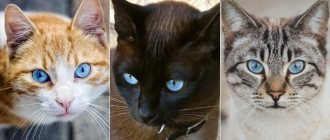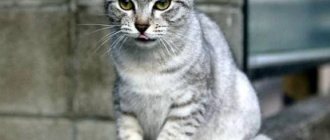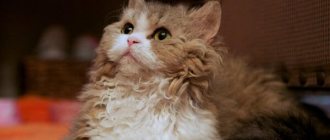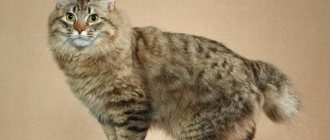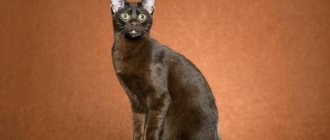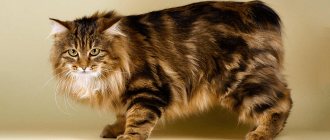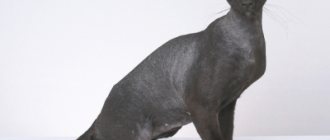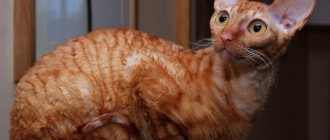History of the Burmese cat breed
Burmese cat
The state of Burma (modern Myanmar) has been famous since ancient times for its delightful landscapes and charm unique only to the countries of Southeast Asia. The virgin nature of the jungle contrasted with the snow-capped mountain peaks, and the white sand of the beaches contrasted with the stone buildings of ancient cities. It was on these mysterious lands that the ancestors of the Burmese breed, one of the most memorable in the world, appeared.
The first mentions of these animals date back to the 12th century. Later, cats were awarded separate lines in the ancient book of poetry, which was replenished with new works during the 14th-18th centuries. No less clear evidence of the ancient origin of the Burmese is provided by the images in the book of Siamese artists, in which, among all representatives of the cat family, an animal with the physique and appearance of our oriental beauty stands out clearly.
The Burmese breed was highly revered by the inhabitants of the ancient state. These cats were allowed into temples because they were considered higher creatures. The monks looked after them in every possible way, thereby demonstrating their commitment to religion and serving the gods. In those days, it was believed that the Burmese cat escorted the soul of its deceased owner to the afterlife, giving him eternal peace as a farewell. According to another legend, the Burmese brought good luck and wealth, so only aristocratic and royal families acquired these cats. Commoners had to be content with more “modest” breeds.
At the end of the 19th century, Burmese cats first set foot on the lands of Great Britain, where the animals were initially known as black Siamese. Over time, the breed spread to all continents of the world. An interesting fact is that the ancestor of the breed in the form in which we know it was not a purebred specimen at all, but a mixed breed of Burmese and Siamese. In the first half of the 20th century, retired American Navy doctor Joseph Thompson acquired a charming kitten named Wong Mau. The baby has grown into a graceful and royally majestic cat of a reddish-brown color with dark tan. Admired by the personality and appearance of his favorite, Thompson began to search for like-minded people who would contribute to the development of a new breed and the creation of its standard. They were scientists from the University of California and enthusiasts from the local felinologists club.
Chocolate Burmese cat
Based on Wong Mau's resemblance to a Siamese cat, Joseph Thompson chose the ideal partner for her breeding - a Siamese named Tai Mau. The first litter produced babies of several colors: seal point and dark walnut. This meant that Thompson’s favorite was a mix of Siamese and Burmese breeds: otherwise the marks would not have appeared. However, the decisive criterion when selecting kittens for further breeding was the chestnut color.
Crossing the offspring of Wong Mau and Tai Mau “gave” three colors: chocolate with dark tan, brown and sable. Of these, Joseph Thompson liked the last one the most. According to the retired doctor, it was this color that looked the most noble and deserved further development.
Burmese kitten
The colossal experience of felinologists played a role: in 1934 the world saw the first standard of the Burmese breed. At the same time, three generations of its representatives were registered. Two years later, the American organization CFA registered the Burmese standard. Considering that work on creating a new breed began only in 1930, such early success could be considered triumphant.
Burmese cats enjoyed universal love and recognition, but the number of individuals remained very limited. To make the breed more widespread, it was decided to cross the Burmese with Siamese and other cats whose color was a bit like Wong Mau. This resulted in a huge number of Mestizos, and in 1947 the CFA stopped registering them. Since then, the pedigree of each kitten was carefully checked: so, it had to include at least three purebred generations.
The ranks of Burmese breeders have thinned significantly, and employees of American nurseries have entered the arena. Thanks to their efforts and organized work to revive the breed, registration of Burmese cats was resumed in 1957: the number of purebred individuals increased several times. A year later, the UBCF organization began to develop a generally recognized breed standard. The result was achieved in 1959 and has not been changed since then. As for color, the first CFA registered was brown, later nicknamed sable due to its resemblance to the fur of this animal. Long-term crossbreeding resulted in the appearance of other coat colors: platinum, blue, golden (champagne).
Burmese cats did not limit themselves to conquering the United States and continued to walk around the world with soft paw pads. In 1949, three representatives of this breed appeared on the lands of Great Britain and aroused universal love and recognition. Throughout the second half of the 20th century, clubs and societies of Burmese cat lovers were created every now and then in Foggy Albion. To increase their numbers, breeders crossed animals with the Siamese breed, which by that time had acquired features familiar to us. For this reason, noticeable differences appeared in the appearance of English and American Burmese. This is how the second breed standard arose - the European one. It is not recognized by the CFA, just like the American one - by the GCCF organization. Crossbreeding of cats belonging to different standards is prohibited.
Having earned the love of America and England, the Burmese breed set foot on the lands of Australia, where it managed to displace the former favorites - the British and Abyssinians - and gain dizzying popularity. The first Burmese appeared in Russia only at the end of the 20th century, but every year they win the hearts of cat lovers more and more.
Interesting facts about the breed
Burmese cats are the most mysterious cat breed in the world. In their homeland in Burma, these animals were deified; there is even a legend that Burmese cats are the reincarnation of the souls of monks. Nowadays, because of their affection and strong love for their owners, Burmese cats are called “cat-dog” .
Burma loves to “talk”; she can be called the chatterbox of the cat world. So if you are used to silence, then you need to approach the choice of the Burmese breed with all seriousness.
Appearance of a Burmese cat
Looking at the embodiment of elegance and grace in this thin cat's body, one cannot imagine that Burmese turn out to be unexpectedly heavy, once you pick them up. For this feature they have earned a humorous nickname - “bricks wrapped in silk.” Males are always heavier than cats: 4.5-5 kg and 2.5-3.5 kg, respectively.
The Burmese cat is a medium-sized short-haired breed. Belonging to one or another standard determines the appearance of the animal: Americans are stockier in comparison with their relatives from Europe.
American Burmese cat
European Burmese cat
Head and skull
The head of the European Burmese is wedge-shaped, while that of the American Burmese is slightly wider. The frontal part of the skull in both representatives of the breed is smoothly rounded. Pronounced flat “areas” in front or profile are invisible.
Muzzle
Both Burmese breed standards are distinguished by a well-developed muzzle that matches the smooth contours of the head. The transition from nose to forehead is pronounced. Cheekbones are clearly visible. A strong chin forms a straight vertical line with the tip of the nose. The American standard Burmese has a wider and shorter muzzle, but the feet are as defined as the European Burmese.
Ears
The triangles of the ears are located far from each other, and their outer side emphasizes the line of the cheeks (uncharacteristic for adult cats). The wide base flows smoothly into softly rounded tips. Due to the slight tilt of the ears forward, the Burmese always looks alert.
Eyes
Burmese cat eye
The Burmese cat's eyes are set wide apart from each other, quite large and expressive. The slight “eastern” slope of their upper line gives the breed a resemblance to Orientals, while the lower line is rounded. Burmese eyes shimmer in all shades of yellow - from honey to amber, with a rich golden tone being more preferable. Pay attention to an interesting feature: the older the animal, the less bright the color of its eyes appears.
Jaws and teeth
If we compare the jaws of a Burmese cat, it can be noted that the lower one is more pronounced and therefore clearly visible when the animal stands in profile. The bite is correct.
Neck
The Burmese breed is characterized by the presence of a long and thin strong neck.
Burmese cat face
Frame
The cat's compact and fit body is the embodiment of grace combined with the hardness of well-developed muscles. The strong chest has a rounded shape. The Burmese's back is straight from the shoulders to the base of the tail.
Tail
It has a medium length and no bends. While not too wide at the base, it tapers to a gently rounded tip.
Limbs
Burmese cat paws
The Burmese cat's limbs are proportional to its body. They are relatively thin, of medium length. They end in graceful oval-shaped paws. The number of toes on the front and hind legs varies: five and four, respectively.
Coat
Representatives of the Burmese breed are characterized by thin and short hair. It fits tightly to the body of the animal and has virtually no undercoat. To the touch – smooth and silky; shimmers beautifully with every graceful movement of the cat.
Color
The upper part of the Burmese body is darker in comparison with the lower part, and this feature does not depend on the color of the animal. An even tone is preferable, but both American and European standards allow discreet points on the face, ears, limbs and tail. Kittens and young individuals can boast of tiger moire.
Recognized Burmese color standards include sable, blue, chocolate, and platinum (lilac). Nowadays there are various tortoiseshell shades based on them, as well as cream and red colors.
Possible defects
Defects of the Burmese breed include:
- tiger stripes on the limbs of adult cats;
- strongly elongated and oblong muzzle;
- round or oriental eye shape;
- sharp narrowing of the muzzle under the cheekbones;
- noticeable hump on the nose;
- sunken cheeks.
The breed standard also mentions disqualifying characteristics:
- malocclusion and developed upper jaw;
- green or blue eye color;
- irregular tail shape;
- white points on coat;
- strabismus;
- deafness.
Subspecies
| American | European |
| Muscular body of medium length | Long graceful body. |
| Rounded head shape. | The head is wedge-shaped. |
| Round eyes set wide apart. | The eye shape is almond-shaped. |
| The ears are shorter and wider at the base compared to Europeans. | Large ears, pointed at the ends. |
| The tail is shorter than that of the European Burmese. | Long, pointed tail. |
| Color – chocolate, blue, dark brown (sable), tortoiseshell, red. | Color – chocolate, light brown. |
In the photo there are subspecies of the Burmese shorthair cat: European - on the left, American - on the right.
Photo of a Burmese cat
Feeding
Cats of this breed have a good appetite. This must be taken into account when creating a menu. The food must be balanced and contain the required amount of vitamins.
To feed your pet, choose super-premium food. It is desirable to have large kibble in the food, which will prevent the formation of plaque and help get rid of tartar.
If the owner prefers natural feeding, you need to diversify the pet’s diet with boiled or stewed vegetables, cottage cheese and cheese.
Do not give your animal sausages, sausages, smoked meats or other unhealthy foods!
Character of the Burmese cat
Among all the cats, you will not find an animal more devoted and cheerful than the Burmese. Don't expect to find a calm and reserved character in this breed. If the cat suddenly freezes, then know: it won’t last long. It is quite possible that in this way your pet is studying the situation and “planning” an entertainment program for the rest of the day. Activity is a constant companion of Burmese cats until old age. You should not hide your pet’s favorite toys in a box, citing her old age. Many elderly Burmese will still give kittens a head start and happily run after a sunbeam or a fly that came from nowhere.
Who are you?
Representatives of this breed have gained fame as cats with a dog's soul. They love to spend time with their owners and participate in every moment of their life, responding to care with boundless tenderness. Between a person and sleeping in an easy chair, the Burmese will choose the first without hesitation. This cat enjoys physical contact with its owner. She will happily follow on your heels and crawl under the covers at night to get her portion of love.
Burmese cats are sensitive to mood and will take any action in an attempt to bring a smile to your tired face. These animals are reputed to be ardent lovers of intimate “conversations” - and not with their relatives, but with humans. Get ready for your pet to speak in cat language, while keeping prying eyes on you. Her gentle purring will brighten up even the most difficult and unpleasant day.
An interesting feature of the Burmese is their different attitude towards the owner depending on gender. Cats tend to love all family members equally, while a cat happily runs into her arms and fawns only on her favorite. This is striking when there are two individuals of different sexes in the house. The cat is destined to become your best friend, who will relentlessly follow on your heels and try to smooth out your problems with the pleasant weight of his body. Cats prefer to adapt to the mood of the owner and never impose themselves if the owner needs solitude.
The Burmese breed gets along well with other pets. These cats will be able to find a common language even with the most gloomy dogs and will certainly not make a parrot their holiday dinner.
Today I will lead
The Burmese are no less kind to children. They will never scratch a baby for a careless poke or an overly tight hug. Moreover: the Burmese cat will take part in the children's game as much as possible. Her graceful and light jumps delight and often attract all family members who want to admire the flexible beauty. Such attention to the modest person of the Burmese acts as a balm for the soul: the animal will jump even higher, bend even more, wanting to hear sincere exclamations of admiration.
Representatives of this breed cannot stand loneliness, as they constantly need a partner to play with. If you spend most of your time outside the home, take care of your pet's state of mind. A second Burmese cat is an ideal option. Rest assured: the animals will not get bored in your absence, and upon your return they will be able to entertain them with active games of “catch-up”.
Obey
Character and behavior
This breed is jokingly called “cat-dog”: the Burmese is so affectionate to its owner that it follows on his heels, trying to be as close to the object of his love as possible. Being left alone is a real punishment for her. Burmese people begin to get bored and may even become depressed. If your job forces you to be away from morning to evening, get yourself an animal of a different breed.
Burmese people love to be the center of attention. Therefore, if your pet begins to go on a rampage: jumping on sofas and beds, jumping on curtains, throwing frames and souvenirs from shelves - she wants to attract your attention to her person.
The Burmese craving for such demonstration performances continues into old age, so remember: the more you focus on this, the more she will try. There is only one solution: pay more attention to her, and the pranks will subside.
Burmese retain their love of games for many years - this is explained by the delayed maturation of this breed.
Burmese cats get along well with children of all ages. You can even leave little ones next to them without fear that the animal will scratch or bite the little one out of anger or curiosity. And if a child crosses the boundaries of what is permitted, he will simply step aside.
By the way, the Burmese also quickly finds a common language with other pets. However, there is one “but”: only if everyone else recognizes its dominance over themselves and treats the Burmese with due respect.
Burmese cats are not loud, and will only give voice if they want to communicate something to their owner. They have an excellent command of intonation, so communication will be very interesting.
Subtly sensing the owner’s mood, the cat knows how to react to it accordingly: come up and cuddle, or hide out of sight for a while. Burmese are very smart: they can even be taught some tricks. Their flexibility and powerful muscles allow the Burmese to jump up to the human shoulder in a jump.
Expert opinion
Dusheba Vera Ivanovna
In 2010, she graduated from the Moscow State Academy of Veterinary Medicine named after K.I. Scriabin with honors, specializing in veterinary medicine. I regularly attend veterinary conferences, congresses, and webinars.
The Burma should not be allowed to “free range”! Insatiable curiosity can bring disaster to their furry fur: when trying to make acquaintance with a strange dog or cat, Burmese may contract an infectious disease or suffer from aggression. And the Burmese are not at all afraid of cars (you understand what this entails). If you want to walk her outdoors from time to time, be sure to use a leash.
The Burmese loves to relax from vigorous games, watching what is happening outside the window or the wall of the aquarium. This way she relaxes and restores her peace of mind. But remember: many cats have died jumping out of windows in the excitement of the hunt! Therefore, either do not open the windows, or install special strong nets.
The stable psyche of the Burmese allows them not to lose composure even in a stressful and frightening situation. They don't get angry or panic.
Name the cat who always wanted to live together
BasilioLeopold
The Burmese also have some disadvantages. The Burmese can demonstrate leadership habits not only in front of animals, but also in front of the owner, refusing to obey him. Don’t insist, but wait a little: it will go away on its own, and the little bully will turn into a model of complaisance.
In the photo, kittens of the Burmese Shorthair breed
Education and training
Among all breeds, Burmese are distinguished by their high level of intelligence, which is confirmed by many owners of these cats. They can easily open a door that is not tightly closed or reach the switch with their paw to extinguish the large “sun” under the ceiling. With sincere desire and patience, you can easily teach your pet simple dog commands: “Sit!”, “Lie down!” and bring an abandoned toy.
Burmese cats easily get used to the litter box and regularly use it as a toilet, so unexpected “bombs” in slippers and shoes will not lie in wait for you.
Advantages and disadvantages
- beauty;
- affectionate, gentle character;
- bright personality;
- playfulness;
- devotion;
- friendship with children;
- patience;
- placability;
- easy care;
- intelligence and intelligence.
- does not like to be alone;
- lack of fear of strangers and transport;
- shortened nose, cause of difficulty breathing;
- overly curious;
- early puberty;
- high price.
Care and maintenance
Representatives of the Burmese breed are completely unpretentious in care. Short hair only needs brushing once a week (during shedding, it is recommended to do this more frequently). In this case, you can use a special antistatic agent. There is no need to regularly give your beauty a “bath day”: Burmese are very clean by nature and therefore monitor the condition of their fur on their own. All you have to do is wipe your cat daily with a barely damp cloth or piece of chamois to remove dead hair and add a glossy shine to the animal's silky coat.
Burmese sable cat
However, if your cat gets dirty somewhere, or you are planning to take first prize at an exhibition, wash your pet with a mild shampoo for short-haired breeds. Do not forget to regularly shorten the nails using a special pruner if the scratching post does not attract your beauty at all.
Particular attention should be paid to feeding the Burmese cat, otherwise you will become a frequent visitor to veterinary clinics. It's worth shelling out for premium dry food. They contain a complex of vitamins and minerals that will allow the Burmese to maintain its noble appearance, and its coat to shimmer beautifully in the light.
It is not recommended to feed the animal the same thing. Burmese cats can be very picky, and it is possible that after a month they will not even approach a bowl filled with their previously beloved food. It is recommended to dilute the animal’s diet with solid food: this will prevent the formation of tartar.
Burmese kitten
Please note an important feeding feature. As long as there is a mischievous kitten running around your apartment, you should not limit its food intake. However, this cannot be said about an adult animal, which easily gains weight and soon turns into a clumsy bun on its feet. Make sure that your heart does not melt at the pitiful, pleading look of the Burmese, and the cat will retain its natural elegance for a long time.
After a fun feast, is there a lot of food left? Don’t rush to share it with an animal: not all “human” foods are easily digestible. Should be excluded:
- pickled, spicy and fried foods;
- vegetables – tomatoes, garlic, onions;
- from fruits - raisins and grapes;
- pork in any form;
- boiled potatoes;
- tubular bones;
- legumes;
- mushrooms.
Drinking water must be filtered. If you want to pamper your Burmese, buy premium bottled water. But you shouldn’t boil it: this can lead to the development of urolithiasis in your pet.
Sweet Dreams
Care instructions
Caring for a Burmese cat is quite simple.
Eyes
If there is excess tear secretion, wipe the eyes daily with a cotton pad soaked in a special lotion.
Nose
American Burmese suffer from runny noses quite often, so keep a close eye on the cleanliness of their nasal passages.
Wool
Photo of a Burmese cat
Brushing the fur once a week is enough: this not only removes excess hair, but also stimulates blood circulation, improving the condition of the skin and coat.
For care, it is enough to purchase a hard brush or rubber (silicone) mitten, and before the exhibition, go over the skin with a piece of silk or suede. This simple manipulation will add shine to the coat.
Ears
Excess ear wax is removed as needed: about once a week or more often. Use a damp cotton swab, but do not pour anything into the ear!
Teeth
Teeth are brushed once every 7 days using cat toothpaste and a special silicone brush.
Bathing
The Burmese cat does not like to bathe, so you should not do this without a reason. And the coat of this breed is impervious to dirt.
You can choose any filler for the tray, as well as a scratching post: the main thing is that the pet is comfortable.
Health and diseases of the Burmese cat
Among all breeds, it is the Burmese that has strong immunity. These cats are not susceptible to hereditary diseases, which makes them excellent specimens for selection. But pathologies from which the Burmese suffer are still observed. Among them:
- labored breathing;
- severe lacrimation;
- skull deformation;
- inflammation of the gums;
- tail defects.
To maintain your pet's health, it is recommended to visit a veterinarian regularly and get vaccinated. Anthelmintic drugs should be firmly established in the animal “first aid kit”. Even if your cat does not go for walks, it is necessary to give the medicine every six months. If you are regularly away from home – once every three months.
Diseases
Burmese cats have strong immunity and hereditary diseases can literally be counted on one hand.
- Chronic cardiac edema (fibroelastosis): manifests itself in the first days after birth. Symptoms: difficulty breathing, quickly leading to death. There is no treatment.
- Gangliosidosis (lack of enzymes in the body): manifests itself at 3 months. The kittens' hind legs begin to fail, they go blind and suffer from epileptic seizures. They die a few weeks after the attacks appear. There is no treatment.
- Deformation of the chest (cause: viral infection; poor quality food in a pregnant cat). A whole range of procedures is required, including wearing a corset and special nutrition.
- Hypokalemia is a lack of potassium. May cause death or paralysis. He is being treated.
- Hernia of the meninges cannot be treated.
- Defects in the front part of the skull: cleft palate, misaligned jaws, deformed ears, absence of a nose. Surgery may improve the condition slightly.
- Dry keratitis: congenital pathology. Lifelong maintenance therapy is required.
How to choose a kitten
Burmese kittens are separated from their mother at the age of 3-4 months, when the physical and psychological health of the babies is no longer at risk. Be prepared for the fact that, due to the characteristics of the breed, kittens may look significantly smaller than their relatives, but this is by no means a defect. Don't be confused by clear discharge from the eyes: this liquid serves to cleanse them. However, the yellow or white color of the “tears” should be an alarm bell and a reason to visit the veterinarian.
The color of Burmese kittens takes up to a year to develop, so the sable coat initially has shades of beige. If you are planning to get a pet to participate in exhibitions, pay attention to an adult animal.
It is best to purchase purebred Burmese from specialized nurseries: this way, the chances of getting a cat full of energy and health in the future increase significantly. The bird market is the last place you should go in search of your future friend.
Tips for choosing a kitten
To make a safe purchase, avoid bird markets and free classified ads posted online. Opt for large nurseries with good reviews, ready to confirm the legality of their activities with all the necessary documents. The only disadvantage of such establishments is the high price for furry pupils.
Burmese kittens up to 3 months old are up for sale. If you want to buy a show-class pet, then choose an animal over 1 year old. Until this age, light brown tints in the sable color are acceptable, which interferes with an adequate assessment of the exterior. The final cost of the kitten consists of the costs incurred and compliance with the standard.
When choosing a kitten, consider:
- Appearance of a kitten. Have a preliminary consultation with a felinologist or an experienced breeder. Take a photo with you to make sure the exterior matches, and carefully examine the kitten for possible pathologies. A disheveled appearance, red or watery eyes, an unsteady gait and a bloated tummy are warning signs that indicate a sick animal.
- Parents' appearance. Pictures posted on the Internet do not always correspond to reality. Insist on meeting your parents in person to prevent miscegenation.
- Provided documents. The seller is obliged to provide the buyer with a sales contract and breeding documents confirming the origin of the kitten and its parents. If the kitten is more than 3 months old, then a veterinary passport containing notes on vaccinations is added to the listed documents.
The danger of buying a mixed breed lies not so much in non-compliance with the standard (which is not scary if you did not intend to participate in exhibitions), but in the likelihood of buying an animal with genetic diseases.
Photos of Burmese kittens
Why do some cats cause allergies and others not?
Unfortunately, any cat can cause this disease. Many people mistakenly believe that it is wool that is the provoking factor. In fact, this is not so: a specific protein, FelD1, is produced in the animal’s saliva, which causes allergies. It makes a person suffer from unpleasant symptoms.
The cat licks itself and this protein gets on the fur, then the person inhales its particles and a hypersensitivity reaction is triggered.
Hypoallergenic cats are cats that physiologically produce less FellD1.
It has been proven that cats produce it in large quantities, while kittens, on the contrary, are safer for humans. Also, light-colored pet breeds are the least allergic.
How much does a Burmese cat cost?
The price of a Burmese varies from 15 to 35 thousand rubles, depending on the place where the animal was purchased and its pedigree.
Abroad, these figures increase significantly: from 32 to 40 thousand rubles. The price may be lower in pet stores, but don't be fooled by that. However, if you need a loyal friend, and not a future exhibition winner, you can take a baby without an outstanding pedigree. Fortunately, many nurseries provide a choice between elite kittens and those with disqualifying characteristics. The latter are often sold with the condition of mandatory castration, since such animals are not suitable for breeding and development of the Burmese breed.
Buy a Burmese kitten
global $ads_google;
//data-ad-slot=”2475549904″ $ads_google = empty($ads_google) ? false : true; ?> if ($ads_google == false) {?> $ads_google = true; ?> } ?> Since the Burmese breed is quite widespread in the world, buying a kitten will not be so problematic. The main selection criterion is to purchase a cat in a nursery, and not a cat in a poke on Avito. Kittens from nurseries at 3 months are already litter box trained, have completed vaccination and quarantine courses, switched to cat food and are completely healthy.
The average price for Burmese kittens in Russia is 20,000 rubles.
Conclusions about the breed
The Burmese cat is an amazing animal from Southeast Asia. Among her undoubted advantages are not only her pretty appearance and innate grace, but also her friendly character. Thanks to him, the pet finds a common language with all the inhabitants of the house. The Burmese is unusually playful and active. It seems that she only stops when she is planning her next entertainment.
The main thing a cat needs is the attention and love of its owner. But he, in turn, must repay the affection, caresses and unobtrusive purring by creating all the conditions for the healthy development of his pet. Not only proper nutrition is important, but also regular coat care, which does not take much time.
Varieties
After the American breeder Thompson introduced the beautiful Burmese to the world, the Europeans decided to take up the matter. They sought to improve the breed, providing the pet with lighter weight and refinement. Americans were not delighted with such innovations. This is what easily forms the basis for dividing the breed into two varieties.
Table - Differences between American Burmese and European Burmese
| Part of the body | American type | European type |
| Coat color | — Sable; - champagne; - platinum; - blue | - Chocolate; - brown; - blue; - lilac; - cream; - red; - blue tortoiseshell; - brown tortoiseshell; - lilac tortoiseshell; - chocolate turtle |
| Eyes | — Large, round; - surprised; - “childish” look | - Slightly inclined towards the tip of the nose; - the upper line of the eye is smooth, and the lower line is rounded; - look “from under your brows”, somewhat stern |
| Ears | - Medium size; - seem vertical, since they are somewhat closer than that of a European | - Low set; - longer; - slightly tilted forward |
| Muzzle | — Round; - full cheeks; - no flat areas | — Shape of a blunt short wedge; - wide cheekbones; - pronounced strong chin |
| Body type | — Compact, muscular; - heavy build; - strong, short limbs | — Elegant, sophisticated; - lighter frame; - thin, long limbs |
Possible defects
Breed defects:
- stripes on the limbs of adult representatives;
- oblong muzzle;
- excessively round eyes;
- sharp narrowing under the cheekbones;
- noticeable hump on the nose;
- sunken cheeks.
A cat is disqualified for the following pathologies:
- overdeveloped upper jaw, defective bite;
- green or blue eyes;
- crooked tail;
- white spots on the fur;
- strabismus;
- deafness.
Brief information and highlights
The Burmese cat is a short-haired cat with an overly active temperament. It seems that to this day the golden-honey echo of the sun of the Ancient East - the historical homeland of the Burmese - shines in her eyes. Few will remain indifferent after becoming closely acquainted with this charming creature both in appearance and character. The breed differs from its fellows in its extraordinary intelligence, prudence and wisdom.
According to ancient beliefs, Burmese cats bring happiness and prosperity to the home. Provided that the owner and all members of his family truly become friends with the pet.
Short Description:
- the official name of the breed is the Burmese cat;
- place of origin - the ancient state of Burma;
- the average weight of the animal is 6-9 kg;
- life span – 11-16 years.
Key aspects:
- Burmese cat is a true dog in cat form, which is not inferior in affection and love to its owner. I am ready to be with him around the clock.
- Despite its impressive dimensions, this extremely graceful, elegant animal is a clear paradox. That’s why such representatives are often called “bricks in silk clothes.”
- There are two varieties of Burmese cats - American and European. They differ in appearance from each other.
- Playfulness and cheerfulness remain among the Burmese into old age. Even older individuals will not mind chasing a ball or other object thrown by the owner.
- The animal intuitively understands what mood the owner is in. If he is not in a good mood, he will not bother him with his presence or, on the contrary, will try to cheer him up.
- These cats do not require privileged living conditions. So anyone can have it at home, even those who have decided to do so for the first time.
- Burmese do not conflict with other domestic animals living in the neighborhood. But, only in the absence of hostile manifestations on their part.
- Burminese are suitable for families with children. Exotic cats are lenient towards children and are ready to play around with them and play mischief.
- Burmese are naturally intellectually developed and easy to train.

